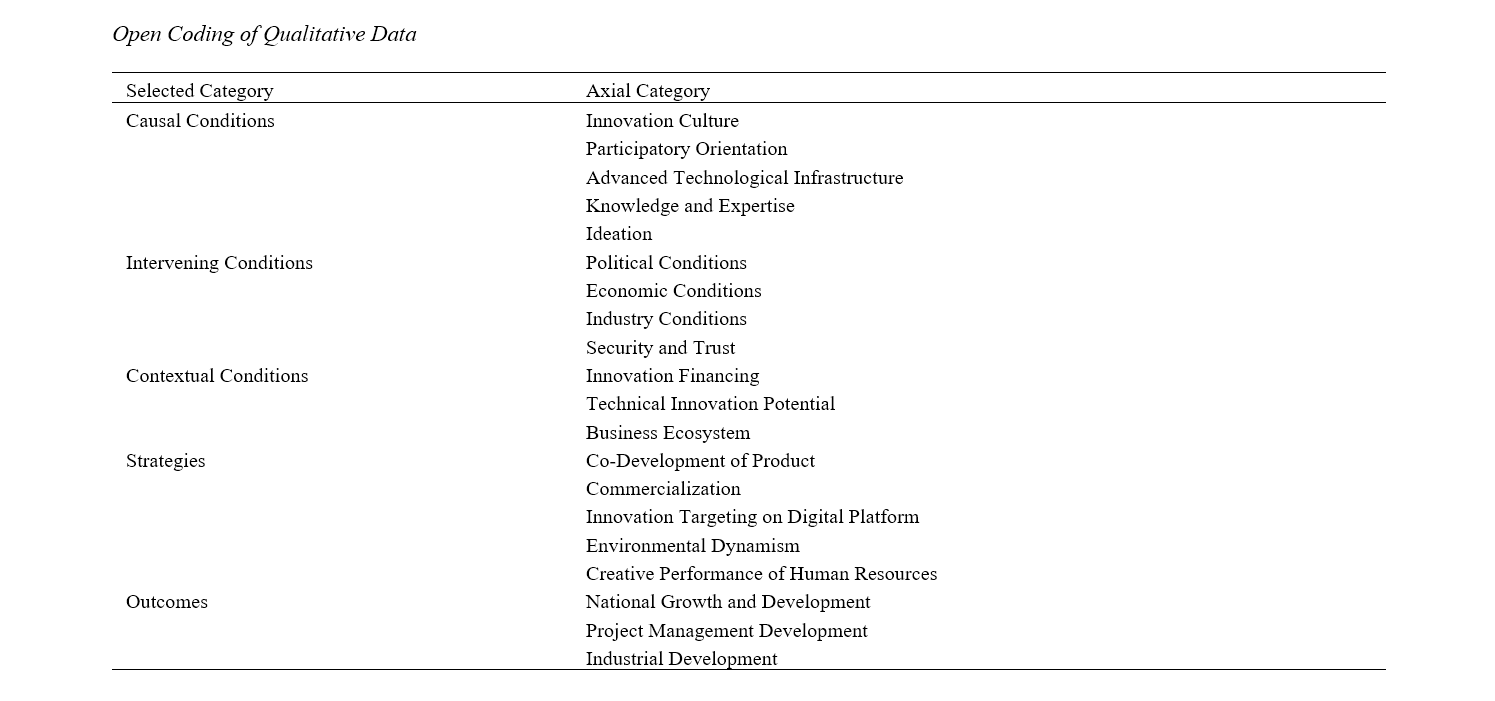Importance-Performance Matrix Analysis (IPMA) of the Open and Collaborative Innovation Model on a Digital Platform
Keywords:
Open innovation, Collaborative innovation, Digital platform, IT industry, Digital transformationAbstract
The aim of this study is to analyze the Importance-Performance Matrix Analysis (IPMA) of the open and collaborative innovation model based on a digital platform. This research is exploratory in nature with regard to its objective and is classified as descriptive-analytical in terms of methodology. It was conducted through a cross-sectional survey using a mixed exploratory method that integrates qualitative (grounded theory) and quantitative (importance-performance analysis) approaches. The statistical population for the qualitative phase included managers and experts from IT industry companies in Tehran in 2023, while the quantitative phase involved an unlimited population of banking industry customers. Using purposive sampling, 14 individuals were selected for the qualitative phase, and according to Cochran’s formula, 384 individuals were selected for the quantitative phase. Semi-structured interviews were employed to identify relevant components based on the grounded theory technique. In the quantitative phase, partial least squares (PLS) analysis was used to determine relationships among variables and their respective importance coefficients, while component ranking was carried out using Importance-Performance Matrix Analysis. Based on Delphi results, a researcher-developed questionnaire was used in the quantitative part. ATLAS.ti software was utilized in the qualitative phase, and SMARTPLS software was employed for the quantitative analysis. The results indicated that causal conditions had the highest degree of importance (0.715), while contextual conditions demonstrated the highest performance score (71.363). The analysis reveals that the success of the open and collaborative innovation model on a digital platform requires simultaneous attention to strengthening causal conditions and maintaining high performance in contextual conditions. Such an approach can ensure the long-term success of this model within organizations.
References
Asgharnia, M., Ahmadi Zadeh, A., & Farhadi, R. (2022). Challenges and Requirements for Implementing Digital Transformation Strategies in the Telecom Industry. Business Reviews, 6(2), 98-117. https://ensani.ir/fa/article/523117/
Audretsch, B. D., & Belitski, M. (2023). The limits to open innovation and its impact on innovation performance. Technovation, 119, 102519. https://doi.org/10.1016/j.technovation.2022.102519
Bao, Z., & Wang, C. (2022). A multi-agent knowledge integration process for enterprise management innovation from the perspective of neural network. Information Processing & Management, 59(2), 102873. https://doi.org/10.1016/j.ipm.2022.102873
Bertello, A., De Bernardi, P., & Ricciardi, F. (2024). Open innovation: status quo and quo vadis - an analysis of a research field. Rev Manag Sci, 18, 633-683. https://doi.org/10.1007/s11846-023-00655-8
Butter, M., Gijsbers, G., Goetheer, A., & Karanikolova, K. (2020). Digital innovation hubs and their position in the European, national and regional innovation ecosystems. In D. Feldner (Ed.), Redesigning organizations. Springer. https://doi.org/10.1007/978-3-030-27957-8_3
Daiberl, C. F., Oks, S. J., & Roth, A. (2019). Design principles for establishing a multi-sided open innovation platform: lessons learned from an action research study in the medical technology industry. Electron Markets, 29, 711-728. https://doi.org/10.1007/s12525-018-0325-2
Eshaghian, Z., Jafari, S. M. B., & Yazdani, H. R. (2022). The Innovation Framework of Business Models Based on the Application of Digital Technologies. Innovation Management in Defense Organizations, 5(2), 1-26. https://www.qjimdo.ir/article_152706.html
Georgescu, A., Avasilcai, S., & Peter, M. K. (2021). Digital innovation hubs-The present future of collaborative research, business and marketing development opportunities. In J. L. R. M. K. P. R. C. S. L. Á. Rocha, s. Z. Bogdanović Ser - Smart innovation, & V. O. L. technologies (Eds.), Marketing and smart technologies. Springer. https://doi.org/10.1007/978-981-33-4183-8_29
Hanley, D., Li, J., & Wu, M. (2022). High-speed railways and collaborative innovation. Regional Science and Urban Economics, 93, 103717. https://doi.org/10.1016/j.regsciurbeco.2021.103717
Jugend, D., Fiorini, P. D. C., Armellini, F., & Ferrari, A. G. (2020). Public support for innovation: A systematic review of the literature and implications for open innovation. Technological Forecasting and Social Change, 156, 119985. https://doi.org/10.1016/j.techfore.2020.119985
Karimi Mousa, S., Sannavi Fard, R., & Hamidi Zadeh, A. (2022). Designing a Digital Technology Model on the Environment and Strategic Marketing Capabilities of Hamadan Oil Products Distribution Company. Strategic Studies in Oil and Energy, 14(53), 39-54. https://ensani.ir/fa/article/508942/
Klos, C., Spieth, P., Clauss, T., & Klusmann, C. (2021). Digital transformation of incumbent firms: a business model innovation perspective. Ieee Transactions on Engineering Management. https://portal.findresearcher.sdu.dk/en/publications/digital-transformation-of-incumbent-firms-a-business-model-innova
Marion, T. J., & Fixson, S. K. (2021). The transformation of the innovation process: How digital tools are changing work, collaboration, and organizations in new product development. Journal of Product Innovation Management, 38(1), 192-215. https://doi.org/10.1111/jpim.12547
Nambisan, S., Wright, M., & Feldman, M. (2019). The digital transformation of innovation and entrepreneurship: Progress, challenges and key themes. Research Policy, 48(8), 103773. https://doi.org/10.1016/j.respol.2019.03.018
Putri, S. R. R., & Fontana, A. (2022). Surviving digital transformation era through strategic entrepreneurship with collaborative innovation between bank and fintech. Proceeding of the International Conference on Family Business and Entrepreneurship,
Sarwar, Z., Gao, J., & Khan, A. (2023). Nexus of digital platforms, innovation capability, and strategic alignment to enhance innovation performance in the Asia Pacific region: a dynamic capability perspective. Asia Pac J Manag. https://doi.org/10.1007/s10490-023-09879-4
Sassanelli, C., Panetto, H., Guedria, W., Terzi, S., & Doumeingts, G. (2020). Towards a reference model for configuring services portfolio of digital innovation hubs: The ETBSD modelBT - Boosting collaborative networks 4.0. PRO-VE 2020. In H. A. L. M. Camarinha-Matos, A. O. S. E. R. I. a. i. information, & V. O. L. communication technology (Eds.). Springer. https://doi.org/10.1007/978-3-030-62412-5_49
Saura, J. R., Palacios-Marqués, D., & Ribeiro-Soriano, D. (2023). Exploring the boundaries of open innovation: Evidence from social media mining. Technovation, 119, 102447. https://doi.org/10.1016/j.technovation.2021.102447
Serrano-Ruiz, J. C., Ferreira, J., & Jardim-Goncalves, R. (2024). Relational network of innovation ecosystems generated by digital innovation hubs: a conceptual framework for the interaction processes of DIHs from the perspective of collaboration within and between their relationship levels. J Intell Manuf. https://doi.org/10.1007/s10845-024-02322-5
Vial, G. (2021). Understanding digital transformation: A review and a research agenda. Managing Digital Transformation. https://doi.org/10.4324/9781003008637-4
Volpe, M., Veledar, O., Chartier, I., Dor, I., Ríos Silva, F., Trilar, J., & Kiraly, C. (2021). Experimentation of cross-border digital innovation hubs (DIHs) cooperation and impact on SME services. In X. B. L. M. Camarinha-Matos, H. A. S. E. R. I. a. i. information, & V. O. L. communication technology (Eds.), Smart and sustainable collaborative networks 4.0. PRO-VE 2021. Springer. https://doi.org/10.1007/978-3-030-85969-5_39
Wang, X., Li, Y., Tian, L., & Hou, Y. (2023). Government digital initiatives and firm digital innovation: Evidence from China. Technovation, 119, 102545. https://doi.org/10.1016/j.technovation.2022.102545

Downloads
Published
Submitted
Revised
Accepted
Issue
Section
License
Copyright (c) 2024 Fariba Goodarzi (Author); Hossein Moinzadeh; Hossein Adab (Author)

This work is licensed under a Creative Commons Attribution-NonCommercial 4.0 International License.









